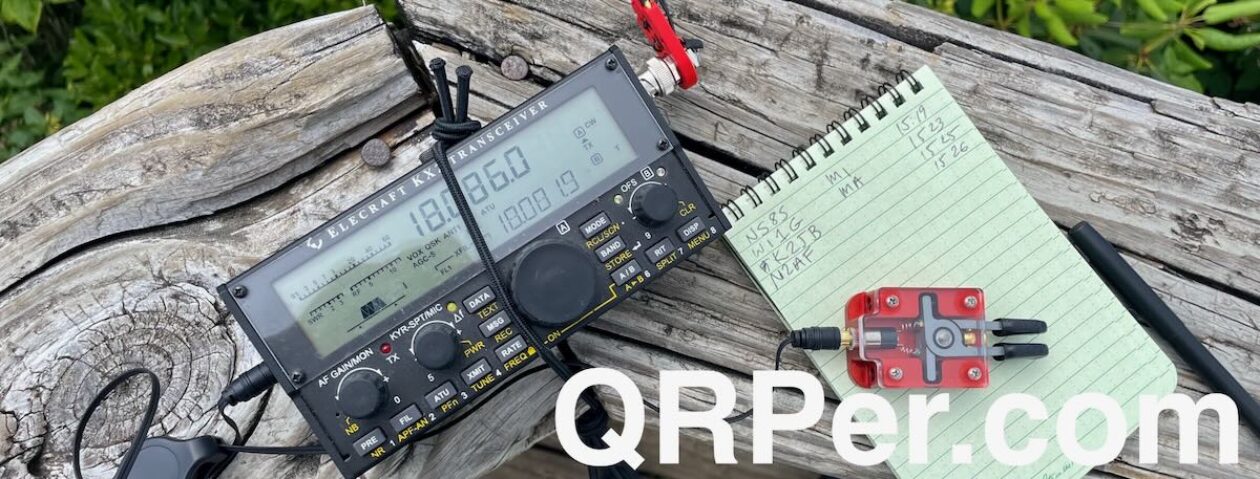 If you were hunting POTA contacts last week, you might have seen my callsign pop up in the spots quite a few times at New River State Park (K-2748).
If you were hunting POTA contacts last week, you might have seen my callsign pop up in the spots quite a few times at New River State Park (K-2748).

Our family decided to take a little break from everything–including the internet–and simply enjoy the great outdoors and a little camping in our small travel trailer (caravan).

It was amazing fun.
In terms of radios, I limited myself to two. While we had room for more, I decided in advance I wanted to spend some proper bonding time with my Yaesu FT-817ND.
I’m so glad I did.
I also brought the Elecraft KX2 but primarily planned to use it when operating off-site. This way, I could keep the FT-817ND system hooked up and ready for action at our camp site.
In fact, the KX2 remained in my SOTA pack for the duration of the trip as a grab-and-go. I had an absolute blast with it activating the summit of Mount Jefferson.
Solar power
This camping trip gave me an excuse to use a station accessory I purchased last year: my Buddipole Powermini 2.
The Powermini 2 is a very compact and capable charge controller with an input for solar panels, a battery, two DC outputs, and even a USB power output. A genius little device.
I’ve been asked a number of times why I don’t do solar charging in the field during my activations. There are a few reasons, actually:
- First of all, my activations tend to be short in duration–perhaps 45 to 75 minutes. I could easily operate for a few hours on one battery charge with most of my QRP radios. In other words, I rarely need to recharge in the field.
- Often, my field activation sites are shaded by choice. Since I like to hang wires in trees, those same trees would block sunlight from ever hitting my panels.
- Finally, unless I’m testing a new radio, I tend to take the least amount of accessories necessary to complete the activation. This is especially the case with SOTA activations. Since I’m unlikely to use solar panels, I leave them in the car or at the QTH. I do, however, keep them packed and at-the-ready should the need arise.
I paired the Powermini 2 with PowerFilm Solar folding panels I purchased many moons ago at Hamvention (I’m guessing in 2012 or so–?). These were blemished units and I snagged them for a brilliant price. Looking back, I wish I would have purchased a few more.
They’re only 5 watts each, but I run them in parallel to feed the charge controller with the equivalent of 10 watts.
QRP gear is so efficient, these modest panels actually do a respectable job keeping the battery topped off. At New River State Park it helped that our picnic table was in full sunlight most of the day.
Sure, we had shore power at the site, but where’s the fun in that?
QRM
During the week, the site had low levels of RFI/QRM. That all changed during the weekend when new campers moved in along with their leaky switching power supplies and noisy inverters.
On Saturday, I found it too frustrating to try making contacts from the campsite–the noise floor was a steady S7 with peaks around S9 simply washing over all but the strongest signals. I regretted not packing my Chameleon loop antenna.
Instead of fighting the QRM, I abandoned it. I drove to a large isolated picnic shelter at New River and set up the KX2 and CHA MPAS Lite antenna.
The site was noise-free and I had amazing fun.
Videos
 I made quite a few activation videos, so I’ll eventually post them with abbreviated field reports.
I made quite a few activation videos, so I’ll eventually post them with abbreviated field reports.
Frankly, I am still catching up from having been offline so long.
Thank you
 Massive thanks to my good friend Eric (WD8RIF) who took care of QRPer.com while I was gone. He’s been moderating comments and making sure scheduled posts published properly. In fact, my friend Robert Gulley (K4PKM) was holding down the fort over on the SWLing Post too. I’m so thankful to both of them.
Massive thanks to my good friend Eric (WD8RIF) who took care of QRPer.com while I was gone. He’s been moderating comments and making sure scheduled posts published properly. In fact, my friend Robert Gulley (K4PKM) was holding down the fort over on the SWLing Post too. I’m so thankful to both of them.
Also, many thanks to all of the hunters who worked me on multiple bands and in multiple modes. A special shot out to NE4TN who was a life saver and spotted me on several occasions when the connection between the POTA site and Reverse Beacon Network were down. Many thanks, OM!
Of course, I’d also like to send a special thanks to those of you who have been supporting the site and channel through Patreon and the Coffee Fund. While certainly not a requirement as my content will always be free, I really appreciate the support. Your support actually helps to make radio fun like this possible.
Here’s wishing everyone an amazing weekend!
Cheers & 72,
Thomas (K4SWL)









